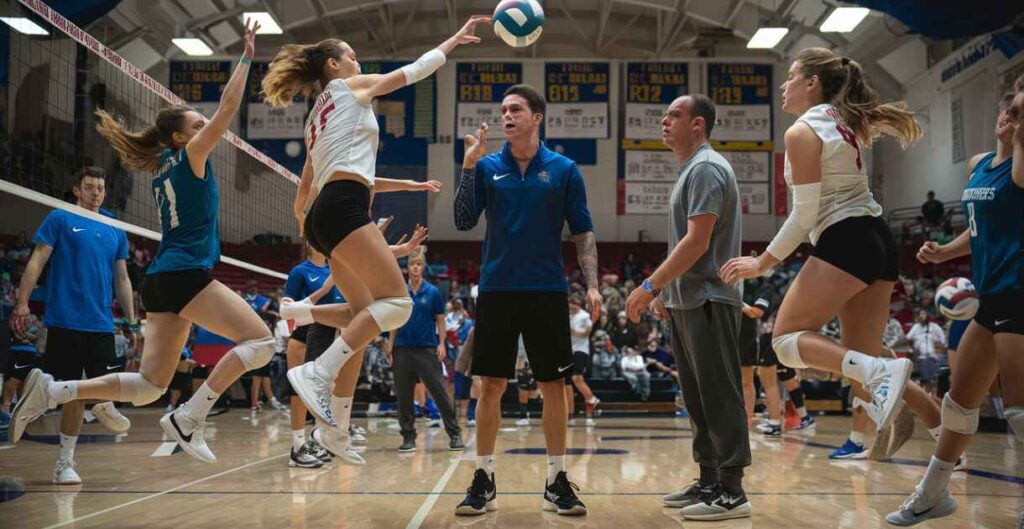Volleyball tryout drills are physical activities designed to evaluate players’ skills and ready for a team. They focus on key features of the game, including passing, serving, setting, and hitting. These drills help coaches assess each player’s power and areas for improvement.
Imagine walking into a gym buzzing with players anxious to show their stuff. Volleyball tryout drills are your possibilities to stand out and verify your skills. Mastering these drills can make a big variance in how you’re perceived by coaches.
In 2024, volleyball tryout drills are further pivotal than ever. These necessary exercises are tailored to showcase your capacity and fit with team dynamics. Preparing well can increase your chances of success and secure your spot on the team.
Essential Skills Assessment for Volleyball Tryout Drills
In volleyball tryouts, coaches assess your core skills by key drills like passing, setting, serve receive, and hitting. Passing tests your accuracy and mechanics, while setting calculate your precision in placing the ball for teammates.
Serve-receive assesses your response time and ability to read work for , and hitting and blocking drills inspect examine your timing and reflexes. These drills also assess your transmission and teamwork, as volleyball relies on successful collaboration.
Coaches look for players who can perform well individually and contribute positively to the team spirit , maintaining a strong attitude all over the tryout.
See Also: How to Wear Volleyball Knee Pads in 2024: A Quick Guide for Maximum Comfort and Safety
Serve and Serve-Receive
The serve is often the beginning point of any volleyball play, and learning it is essential for making a good feeling during tryouts. Coaches will assess your ability to work with power, accuracy, and evenness.
Different types of serves, such as the float serve, topspin serve, and jump serve, each require unique techniques and ball-handling skills. Serve receive, on the other hand, is all about motions , quickness, and reaction.
It’s not just about getting the ball to the setter; it’s relevant doing so in a way that put the team up for a successful attack. Your capacity to communicate with your teammates during serve be given drills will also be a key factor in your evaluation.
Passing Proficiency
Passing is the bedrock of any successful volleyball play. Coaches will assess your ability to consistently deliver correct passes under pressure. This requires not just your technique but also your transmission with your teammates.
A good passer must be allowed to read the game, anticipate the movement of the ball, and react fast. Your ability to stay calm and focused, especially in high pressure situations, will be closely observed during tryouts.
Setting Skills
The setter is often considered the “quarterback” of a volleyball team. Setting needs precise ball-handling and the capacity to make split-next decisions.
Coaches will look for players who can set the ball correctly to dissimilar areas of the court, whether it’s a quick set to the center or a high set to the outside hitter. Your hand form, ball placement, and footwork will all be under scrutiny throughout setting drills.
Hitting and Attacking
Hitting is where the ability and volatile movements come into play. Coaches will assess your approach, sway mechanics, and ability to hit with both power and accuracy.
Hitting drills will frequently require different scenarios, such as hitting from the front row, backwards row, or on the run.Your ability to read the protection , adjust your approach, and make smart attacking resolution will be critical in these drills.
Blocking and Defense
Blocking and protection are all about timing, reflexes, and communication. A good blocker needs to be allowed to read the hitter and time their jump totally to close the block. On defense, quick reactions and the capacity to dig hard driven balls are essential.
Coaches will look for players who are aggressive at the net and can continue a strong defensive presence all over the tryout.
Physical Conditioning and Agility
Volleyball is a fast paced sport that requires not just skill but also a high level of force conditioning and agility. During tryouts, coaches will assess your common fitness, including your stamina, quickness, and volatile movements. These standards are crucial for continuing a high level of performance throughout a match.
Footwork Fundamentals
Good footwork is necessary for every feature of volleyball, whether you are passing, position , hitting, or blocking. Coaches will gauge your footwork during various drills, looking for quick, precise motion that allow you to stay in position and behave to the ball. Proper footwork not only makes your performance better but also helps stop injuries.
Jump and Power
Jumping ability is critical in volleyball, mainly for hitters and blockers. Coaches will assess your vertical jump, power, and capacity to maintain your explosiveness all over the tryout.
This involves not just raw athleticism but also proper technique and conditioning. Your ability to jump high, land care fully , and recover quickly will be key parts in your evaluation.
Quickness and Movement
Quickness and agility are necessary for reacting to the fast walk nature of volleyball. Coaches will look for players who can go fastly and efficiently on the court, whether it’s to make a play on the ball or to protect a teammate. Quickness is not just about speed it’s also about forecast , positioning, and the ability to change direction quickly
Team Dynamics and Gameplay
Volleyball is a team sport, and your ability to work usefully with others will be a significant part of your evaluation throughout tryouts. Team dynamics and gameplay drills are designed to judge how well you communicate, cooperate, and give to the overall success of the team.
Communication and Teamwork
Communication is the cornerstone of successful volleyball gameplay. Coaches will assess how well you meet with your teammates, both verbally and non verbally, during drills and fights. Effective communication helps stop errors, improves teamwork, and can often be the difference between victorious and losing a point.
Game-Like Scenarios
In addition to skill specific drills, coaches will often use game-like scenarios to evaluate your overall gameplay. These plots simulate a real match state , allowing coaches to see how well you perform under pressure. Your decision making, teamwork, and ability to carry out plays in a game-like setting will be closely monitored.
Volleyball Tryout Drills for Large Groups
When tryouts require large groups of players, it can be challenging for coaches to evaluate everyone successfully. Specific drills are designed to assess multiple players simultaneously, focusing on ball-handling skills, general ,and rotational practices,team dynamics.
Ball-Handling Circuits
Ball-handling circuits are designed to test your ability to control the ball in various situations. These drills often require passing, setting, and hitting in quick sequence , requiring you to stay focused and continue proper technique. Coaches will be looking for consistency, correctness , and the ability to hold the ball under pressure.
Rotational Practices
Rotational practices are used to assess how well you adapt to different positions on the court. These drills simulate game conditions, requiring you to rotate through different positions and perform various skills. Coaches will evaluate your versatility, adaptability, and understanding of different roles on the team.
Effective Coaching Strategies
Coaches play a crucial role in the tryout process, and their policy can significantly impact the result . Effective coaching strategies involve careful preparation , clear communication, and impartial player evaluation.
Tryout Planning and Execution
Successful tryouts start with careful planning and carry out . Coaches will typically outline the skills and standard they are looking for in players, then plan drills and exercises that effectively judge these areas. Clear communication of expectations and criteria is essential for making sure a fair and transparent tryout process.
Player Evaluation Methods
Player evaluation throughout tryouts is both an art and a science. Coaches use a variation of methods to assess players, including observing skill execution, evaluating team dynamics, and considering bodily conditioning. Effective player evaluation also involves providing useful feedback to help players make better.
See Also: How to Wash Volleyball Knee Pads in 2024: Ultimate Guide for ambitious Players
Special Considerations for Youth
Youth volleyball players require special considerations during tryouts. Coaches must adapt drills and expectations to suit the developmental levels of younger players, focusing on skill development and fostering a positive attitude toward the game.
Adapting Drills for Development Levels
When working with youth players, it’s main to adapt auger to their developmental levels. This might involve simplifying certain drills, focusing additional on basics , or providing additional advice and encouragement. Coaches should aim to generate a positive, supportive environment that encourages young players to grow their skills and love for the game.
Encouraging Positive Attitudes
In youth volleyball, encouraging a positive attitude is just as main developing skills. Coaches should encourage players to support one another, stay move, and maintain a positive outlook all over the tryout process. A positive view can make a significant variation in a young player’s experience and development.
Conclusion
Volleyball tryout drills are your possibilities to shine and protect a spot on the team. By focusing on key exercises like passing, setting, serve receive, and hitting, you can trap your skills and teamwork. It’s not just about single talent; it’s about how well you fit into the team dynamics.
Preparing well and giving your best in each drill can make all the variance . In 2024, mastering these necessary exercises is the key to your selection success. Stay focused, work hard, and you’ll grow your possibilities of making the team.
FAQs
How many competitors are there in volleyball tryouts?
The number of competitors in volleyball tryouts typically ranges from 15 to 50, on the program.
Can anyone participate in volleyball tryouts?
Most tryouts are open to various skill levels, but some may require pre-registration or specific experience.
How many drills must I complete to pass during a volleyball tryout?
There isn’t a set number of drills to pass, but you need to demonstrate proficiency across essential skills.
How long are volleyball tryouts?
Volleyball tryouts generally last 1-3 days, with each session running 2 to 4 hours.


